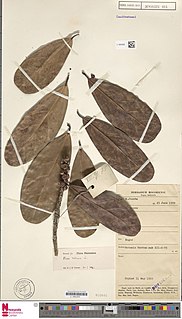
Ficus benghalensis, commonly known as the banyan, banyan fig and Indian banyan, is a tree native to the Indian Subcontinent. Specimens in India are among the largest trees in the world by canopy coverage. It also known as the "strangler fig" because it starts out as epiphyte, that is, leaning on another tree that it ends up suffocating.

Ficus macrophylla, commonly known as the Moreton Bay fig or Australian banyan, is a large evergreen banyan tree of the family Moraceae native to eastern Australia, from the Wide Bay–Burnett region in the north to the Illawarra in New South Wales, as well as Lord Howe Island. Its common name is derived from Moreton Bay in Queensland, Australia. It is best known for its imposing buttress roots.

Quercus laevis, the turkey oak, is a member of the red oak group of oaks. It is native to the southeastern United States, occurring on the coastal plain from Virginia south to central Florida, and west to southeast Louisiana. There they mingle with many tropical trees such as mature coconut palms and large Cuban Laurel (Ficus) trees. The name turkey oak derives from the resemblance of the leaves to a turkey's foot. A Turkish and southern European species Quercus cerris is also commonly referred to as Turkey oak, so Quercus laevis is sometimes referred to as American turkey oak to distinguish it from the European species.

Ficus religiosa or sacred fig is a species of fig native to the Indian subcontinent and Indochina that belongs to Moraceae, the fig or mulberry family. It is also known as the bodhi tree, pippala tree, peepul tree, peepal tree, pipal tree, or ashvattha tree. The sacred fig is considered to have a religious significance in three major religions that originated on the Indian subcontinent, Hinduism, Buddhism and Jainism. Hindu and Jain ascetics consider the tree to be sacred and often meditate under them. This is the tree under which Gautama Buddha is believed to have attained enlightenment. The sacred fig is the state tree of the Indian states of Odisha and Haryana.

Ficus retusa is a species of evergreen woody plant in the fig genus, native to the Malay Archipelago and Malesia floristic region. The species name has been widely mis-applied to Ficus microcarpa.

Juniperus tibetica, the Tibetan juniper, is a species of juniper, native to western China in southern Gansu, southeastern Qinghai, Sichuan, and Tibet Autonomous Region, where it grows at high to very high altitudes of 2,600–4,800 metres (8,500–15,700 ft). This species may possess the highest elevation treeline in the world.

Hyophorbe indica, known commonly as palmier bâtard, palmiste poison, or champagne palm, is a species of flowering plant in the family Arecaceae. It is endemic to the island of Réunion. It is threatened by habitat loss.

Arctostaphylos catalinae, known by the common name Santa Catalina Island manzanita, is a species of manzanita native to Southern California.
Ficus bojeri is a species of plant in the family Moraceae. It is endemic to Seychelles. It is a fairly small ficus, or fig, tree with small branches and oval-shaped leaves. It is greyish-brown in color. The fruit hangs from the trunk of the tree on centimeter long twigs.
Ficus faulkneriana is a species of strangler fig in the family Moraceae native to Africa.
Ficus lacunata is a species of plant in the family Moraceae which is endemic to Ecuador. F. lacunata is a free-standing tree which grows up to 25 m (82 ft) tall in wet forests in the Andes.
Ficus lapathifolia is a species of plant in the family Moraceae. It is endemic to Mexico.
Ficus luschnathiana is a species of plant in the family Moraceae. It is found in Argentina, Brazil, Paraguay, and Uruguay.
Ficus pallida is a species of plant in the family Moraceae. It is found in Brazil, Colombia, and eastern Bolivia. In Bolivia, it is one of a few closely related trees in the genus Ficus popularly known as bibosi.
Ficus panurensis is a species of plant in the family Moraceae. It is found in Brazil, Guyana, Suriname, and Venezuela.
Ficus schumacheri is a species of tree in the family Moraceae. The species is monoecious.

The Mascarene crow is a species of Nymphalidae butterfly in the Danainae subfamily. It is found in Mauritius and Réunion.

Poivre Islands are a group of islands in Seychelles, lying in the Outer Islands of Seychelles, with a distance of 268 km south of Victoria, Seychelles.

Ficus popenoei is a species of fig found in Latin America, from Brazil and Peru up to Guatemala and Belize.
Ficus morifolia can refer to:











